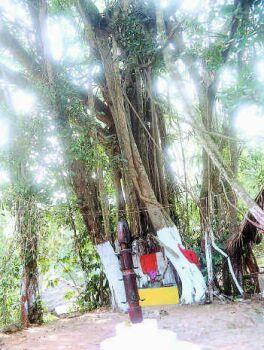Sacred Snake Grove burnt, Idols demolished by Revenue officers

Kollam: In a outrageous incident, Revenue officials here dared to arson a Sarppa Kavvu (Sacred Snake Grove) of Karukon Kuttinadu Siva Temple near Anchal.
In Kerala it was the common practice among Hindus to assign a part of their land near the Tharavadu or house as the abode of goddess Durga or Serpent God Naga or Shasta and the place is called Kavu or Sarpakavu. Sacred Grove represent the major effort to recognize and conserve biodiversity (ethnic diversity) traditionally. The age old system of every village having a temple, a tank and associated sacred grove explains the ancient method of water harvesting and sharing and may be considered as the backbone of village economy. People were prohibited from felling trees and even removing a twig Is considered as a grave sin.
The Holy grove known as Valiya Pannikkan Kavvu was there since time immemorial associated with the Temple. Daily poojas are conducted and Devotees coming to Temple often prays at Sarppakavvu aswell. The Revenue officials justified the arson claiming that the Sarpa Kavvu is in Government land.The Revenue officials destroyed the idols of snakes and stone lamps in the Kavvu, set fire to the grove. An age old sacred Banyan tree was also destroyed by these anti Hindu officials.
Agitated devotees including women and children blockaded the RDO and other Officers. Later heavy contingent of Police came to release the officers. Hindus in the area under Hindu Aikya Vedi and Yuvamorcha lead protest march to Village office and demanded strict action against the officers who did this heinous crime.
When there is a call for the need of preservation of existing Holy Groves, Government itself is taking initiation in destroying these sacred places related to the faith of Hindus. On a rough estimate, Kerala has about 1500 sacred groves, distinct and unique in biological diversity. In fact the area varies from one cent as in some nagaru kavus to more than 20 hectares in Iringole Kavu, ‘Kunnathurpadi kavu, Payyannur and Theyyottukavu, Kannur dist. (16.187 ha) are two other large Kavus in Kerala. A complete inventory of the sacred groves of Kerala is not available.
Protection of the environment and life supporting systems are interwoven with conservation of biological diversity. Sacred groves represent this all-embracing concept and practice of ancient Hindu way of in situ conservation of genetic diversity. Sacred groves, in general act as a nursery and store house of many of the local ayurvedic, tribal and folk medicines. Fruitsare eaten by birds and animals (mostly nocturnals) in the sacred groves.
As an ecosystem, the environmental significance of the sacred groves is a matter well forgotten. In fact, they even help in soil and water conservation besides preserving its rich biological wealth. The ponds and streams adjoining the groves are perennial water sources. These are the last resorts to many of the animals and birds for their water requirements, especially during summer. Sacred groves also enrich the soil through its rich litter composition. The nutrients generated thus are not only recycled Within the sacred grove ecosystem but also find their way into the adjoining agroeco systems.
In spite of the very high land to man ratio, these groves have been thriving, which naturally shows the very high reverence and importance Hindus attach to these sacred groves.All Hindus in the area and Nature lovers should come forward to question this unhealthy tendencies shown by the Government without considering the sentiments of Hindus and it’s environmental impact.
Welcome to Haindava Keralam! Register for Free or Login as a privileged HK member to enjoy auto-approval of your comments and to receive periodic updates.
Latest Articles from Dharma Smriti
- In memory of Dr N Gopalakrishnan
- Treading the Middle-Path on Temple Management
- ആദി ശങ്കര ജയന്തി – പ്രഭാഷണം
- അമേരിക്കന് പ്രൊഫസര് ജോണ് ഗ്രൈംസിന് ഭഗവാന് ഗണേശന് കൊടുത്ത ദിവ്യാനുഭവം
- Forgotten Temples Of Malappuram – Part I (Nalambalam of Ramapuram)
- Holy Karkidakam – Ramayana to Echo from Haindava Homes
- Poonthanam’s complete works translated into English
- Pamba Aarati – Dispell the Engulfing Darkness
- Milords! What the judiciary must know before any final verdict on Sabarimala
- Swami Chidanandapuri on Sabarimala


Responses